The Lost Symbol – A Hastings, New Zealand Connection
An Address by WBro Kerry Nicholls, GS, KL, Junior Warden of the Hawke’s Bay Research Lodge No 305
Hastings, Monday, 3rd May 2010
Introduction
An article in the “National Business Review” regarding New Zealander, Peter Waddell (refer Appendix A), published on 9th April 2010, forms the basis of this paper. I began researching and the results are my presentation to you this evening.
Peter Waddell was born in Hastings, New Zealand, in 1955. His father returned from service in World War II profoundly impressed by the wonders he had seen in Egypt and Rome. His mother was a law clerk with a passion for the theatre. These earliest influences are reflected in all of Waddell's work. Part of a family of voracious readers, Waddell never allowed New Zealand's remoteness to be an obstacle to his imagination. His talent for painting was recognized and encouraged from the start.
Although Waddell formally studied painting, he began his professional life as a schoolteacher, leaving in 1985 to devote his talents to art full time. Critically acclaimed from the beginning, Waddell has had numerous solo shows in New Zealand and the United States. His work is in public and private collections in both countries. Drawn to the art and culture of America, Peter Waddell has been a permanent resident since 1995.
Quoted in the “Washington Post” in August 2001 he said that he views monuments as triggers for memory and Washington's continuing history and its classical architecture were what drew him there in 1995.
I bring a romantic sensibility to buildings and sculptures so familiar they often seem invisible (Peter Waddell).
On 18th May 2005, at the famous Octagon Museum, just three blocks from the White House, an exhibition – The Initiated Eye - premiered twenty-one original paintings that displayed to the world the role that Freemasonry has played in the design and development of the Capital City of America and the country in general.
The paintings exhibited are the work of Peter Waddell and were commissioned by, and are the property of, the Grand Lodge of Free and Accepted Masons of Washington, DC with the exhibition supported by the Scottish Rite Masons of the Northern Masonic Jurisdiction, USA. Currently the exhibition is on display at the National Heritage Museum until January 2011.
 A Vision Unfolds A Vision Unfolds
Upon his arrival in the morning the President met with the three commissioners and then rode out to the survey camp. He reviewed Ellicott’s drawing with the survey and expressed satisfaction with the work. March 28, 1791 Survey of the Federal City, Silvio Bedini, Journal of the Columbia Historical Society
Congress designated the location of the new Capitol on 24th January 1791. It was a ten-mile square parcel of land along the Potomac and Eastern Branch Rivers. Andrew Ellicott and Benjamin Banneker surveyed the tract of land and produced the base map. Banneker, a self taught African American surveyor and astronomer, plotted the locations of the forty boundary stones one mile apart along the entire perimeter. Using this base map, Major Pierre L’Enfant, a French engineer and friend of George Washington laid out the plan of the city sympathetic to the topography of the site.
 Benjamin Banneker (1731 – 1806) Benjamin Banneker (1731 – 1806)
In the painting, a brazier warms the early spring day in a tent filled with surveying instruments and other Masonic items such as the terrestrial and celestial globes. Note in the painting the positioning of the celestial globe.

The Position of the Celestial Globe
The Age of Reason made Manifest
The creative dialogue between Thomas Jefferson, George Washington and Pierre L’Enfant resulted in a classically inspired vision and plan for Washington, DC. Seen laid out on a desk at Monticello, the working plan embodies Masonic and Classical ideals depicted in the models. Although the vast majority of the design was realized, a few key landmarks were never built. The Supreme Court was to have reigned in the form of a Roman temple at the site of Judiciary Square; the Washington Monument was to have been an equestrian statue of George Washington; a Rostral Column, along the lines of a Roman naval trophy column, was to lie south of it; and a cascade flowing from a pyramid was planned to grace the base of Capitol Hill.
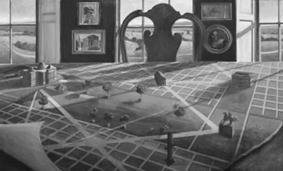
The United States Capitol building was planned as the anchor of the entire design for the Federal City. L’Enfant placed the Capitol on the west end of Jenkin’s Hill, the most prominent hilltop from which it might be seen from twenty mile off.
An Auspicious Day
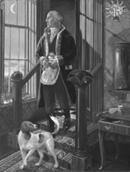
Preparing to lay the cornerstone of the Capitol on 18th September 1793, George Washington is depicted in this painting in full Masonic regalia accompanied by one of his favourite dogs, “Duchess”. After crossing the Potomac from Alexandria, he is likely to have prepared for the ceremony in an upper room of a small dwelling located on New Jersey Avenue South East, the present site of the House Office Building. This was the first meeting place for Federal Lodge No. 1, a lodge formed by stonemasons working on the construction of the White House.
A Meeting at the End of the Day
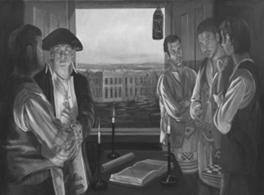
The first Stone of the President’s House was laid on the 13th Day of October 1792, and the 17th Year of Independence of the United States of America. The Charleston City Gazette, November 15, 1792
Stonemasons laboured for almost ten years to complete the design by Freemason James Hoban (c.1762-1831) who had immigrated to America in 1785. Abundant work was available for immigrants with such skill, and Scottish Presbyterian and Irish Catholic stonemasons flocked at the opportunity. Shortly after the cornerstone was laid, they took the opportunity to organize into a Masonic Lodge in 1793, a Lodge that was ultimately to become Federal Lodge No. 1, with James Hoban as its charter Master.
The daily construction work was managed from a building that was conveniently located midway between the White House and the current fountain in Lafayette Park. Wearing silver jewels emblematic of their position in the Lodge, the three main officers, James Hoban, Clotworthy Stephenson and Andrew Estave begin an evening meeting with new brothers. Although James Hoban went on to an illustrious architectural career, little is known of Stephenson and Estave, other than they were both stonemasons and master carvers and were associated with the construction and decoration of numerous federal buildings.
From These Ashes
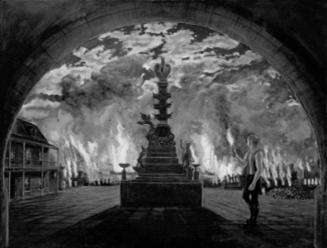 According to tradition, workers in the Washington Navy Yard founded Naval Lodge No. 4 in 1805 in the old sail loft of the Yard. Originally chartered as Lodge #41 of the Grand Lodge of Maryland, Naval Lodge was one of the founding five lodges of the Grand Lodge of the District of Columbia. Freemason Benjamin Henry Latrobe, often called The Father of American Architecture, was summoned by President Thomas Jefferson to work on a federal commission at the newly established Washington Navy Yard. Latrobe transformed a large swampland into one of the first Navy Yards and designed a number of the original structures including the massive, arched entrance gate. According to tradition, workers in the Washington Navy Yard founded Naval Lodge No. 4 in 1805 in the old sail loft of the Yard. Originally chartered as Lodge #41 of the Grand Lodge of Maryland, Naval Lodge was one of the founding five lodges of the Grand Lodge of the District of Columbia. Freemason Benjamin Henry Latrobe, often called The Father of American Architecture, was summoned by President Thomas Jefferson to work on a federal commission at the newly established Washington Navy Yard. Latrobe transformed a large swampland into one of the first Navy Yards and designed a number of the original structures including the massive, arched entrance gate.
In August 1814 the British burned the majority of the Federal Buildings in Washington, DC, but Captain Thomas Tingey in an effort to prevent the capture of armaments burned the Washington Navy Yard. Through the gate can be seen the Tripoli Monument, the oldest military monument in the United States. It was dedicated to six naval officers killed in the war with Tripoli in 1803.
First Light of Morning
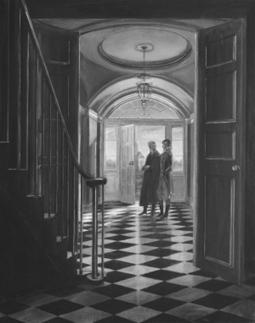
Decatur House is one of the most distinguished homes historically, as well as architecturally, in Washington, DC. Freemason Benjamin H. Latrobe designed the house. It was built in 1819 on a site of great significance near the President’s house for Freemason Stephen Decatur, one of the most important naval officers in the history of the United States. Decatur wanted the house to be sturdy as a ship in construction and of great simplicity of design. The results were an extremely restrained and beautifully proportioned cubic structure of red brick with a hip roof. Decatur was killed in a duel with a fellow officer on March 22nd 1820. Decatur is depicted in the vestibule of his home with President James Monroe on the morning of the duel with another Latrobe masterpiece, St. John’s Church, in the distance. Compared to the façade of Decatur House, the vestibule is far from plain or simple. It is a highly refined combination of a rectangle, square and semicircle in black and white marble that is offset by a barrel vault, shallow dome and semicircle above.
Centrepiece of the New Republic
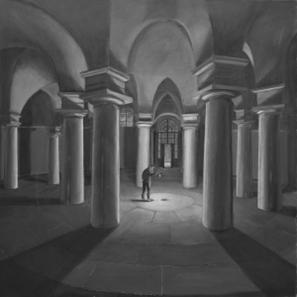
The crypt of the United States Capitol Building was designed to hold the body of George Washington. It is also the centrepiece of Washington, DC, since it is the dividing point for the quadrants of the city. The founding fathers envisioned a far greater role that was never realized.
Inset in the centre of the crypt is a brass compass rose, the location for the New Republic’s new prime meridian to replace the Greenwich prime meridian. From this point all distances would be measured including a one-mile standard established between the compass rose and a massive column to be constructed exactly one mile east of the Capitol. From it would be surveyed all lines for future states.
The tremendous weight of the rotunda is transferred to the crypt through delicate elliptical vaults onto a double and single circle of unfluted Doric columns.
Laying Down the Working Tools

The original Potomac Lodge is located along the towpath of the Chesapeake and Ohio Canal at Jefferson Place in Georgetown. On 21st April 1789, at a meeting in Easton, Maryland, the Grand Lodge of Maryland granted the petition of a number of respectable brethren from George Town on the Patowmack (Potomac) River and issued a charter establishing Lodge No 9 of Maryland, the first regularly chartered lodge in what is now the District of Columbia. Tradition has it that the first life size statue of George Washington was displayed in the large niche in the second floor of the facade of the lodge.
 The funeral ceremony, in which a brother ceases his labour in the terrestrial lodge and hopes to receive his reward in the celestial lodge, is one of the most moving of all Masonic ceremonies. In the painting, an ordered procession of lodge officers moves from the lodge over the bridge to the final resting place of a brother. The funeral ceremony, in which a brother ceases his labour in the terrestrial lodge and hopes to receive his reward in the celestial lodge, is one of the most moving of all Masonic ceremonies. In the painting, an ordered procession of lodge officers moves from the lodge over the bridge to the final resting place of a brother.
The Cornerstone of the Nation
In 1824 an American bald eagle presided over the welcoming parade for French General Lafayette in Alexandria, Virginia. From atop a triumphal arch this same eagle witnessed one of the most auspicious events of the new republic, the laying of the cornerstone of the Washington Monument on July 4th 1848. The largest crowd to date in the capitol city gathered on a bright, clear and promising day to celebrate the seventy-second anniversary of the new nation, and the thirty-star American flag was publicly displayed for the first time.
A reporter from the “Daily Intelligencer”, Washington’s leading newspaper, described the crowd in colourful language:
It were long to tell of the many bright-colored country bonnets which bustled and swayed about in the crowd, like poppy-heads shaken in the wind
The greatest parade the city had ever seen proceeded from the City Hall to the grounds of the monument. Included were every branch of the military in full dress, numerous bands, and countless dignitaries. President James K. Polk, a Freemason, presided over the event. The early years of the republic were represented on the dais by Dolley Madison, in her last public appearance, Mrs. Alexander Hamilton, widow of the first Secretary of the Treasury, and George Washington Parke Custis, adopted son of George Washington. Robert C. Winthrop, Speaker of the House, gave the principal address at the ceremony. He spoke of the nation’s debt to George Washington and said:
 One tribute to his memory is left to be rendered…a national monument erected by the citizens of the United States of America…Of such a monument we have come to lay the cornerstone…. The place is appropriate, here on the banks of his beloved and beautiful Potomac. One tribute to his memory is left to be rendered…a national monument erected by the citizens of the United States of America…Of such a monument we have come to lay the cornerstone…. The place is appropriate, here on the banks of his beloved and beautiful Potomac.
The subtle transition from operative masonry to speculative Freemasonry is eloquently illustrated in the cornerstone laying ceremony. Freemasons routinely set cornerstones of major public buildings with an ancient ritual emblematic of the higher role of the builder to his creator.
Born in 1800 in Chester, New Hampshire, Benjamin Brown French, Clerk of the House of Representatives and Grand Master of Masons of Washington, DC, ceremonially laid the 24,500-pound marble cornerstone using the same trowel that George Washington had used when the cornerstone of the U.S. Capitol was laid in 1793.
Bro French presented to his Masonic Brother, Robert Mills, the architect of the monument, the working tools, remarking: -
I now present to you, my Brother, the square, level, and plumb, which are the working tools you are to use in the erection of this monument. You, as a Freemason, know to what they morally allude: the plumb admonishes us to walk upright in our several stations before God and man, squaring our actions by the square of virtue, and remembering that we are travelling upon the level of time to the “undiscovered from whose bourne no traveller returns.” Never forget this sublime moral lesson, you are here to use them practically in your profession. Look well to the erection of this National Monument; see that every stone is well squared, and that it is placed in its position both level and plumb, that the noble offering of a nation to commemorate greatness, patriotism, and virtue, may stand until the end of time.
Onto the stone was poured corn, wine and oil, emblematic of health, prosperity and peace. Witnessed by thousands, this ancient ceremony was a validation for the young republic that all was ‘well formed, true and trusty’ and an assurance of our strength and prosperity.
Equality in Initiation
In this painting are depicted Vinnie Ream and Albert Pike. Ream was the most prominent American female sculptor of the 19th century. She received the coveted job of producing a life-size marble statue of Abraham Lincoln in 1866 that stands in the United States Capitol rotunda and the bronze statue of Admiral Farragut in Farragut Square. Albert Pike was a philosopher, jurist, orator, poet, scholar, soldier, author of many of the rituals of Freemasonry and Grand Commander of the Scottish Rite Masons. They met around 1868 when Pike settled in Washington. Both were ambitious and charismatic. Interestingly, Pike generated a series of Freemasonry rituals intended for women and initiated Ream into the Masonic fraternity.
The Lamp of Knowledge

The Franklin School was completed in 1868 and was designed by Adolph Cluss of Lafayette Lodge No 19. It is a focal point of McPherson Square. The school was a model of advanced design in its day and the scene of Alexander Graham Bell’s first telephone message. The design of Franklin School won many national and international prizes for its advancement of educational practices. It is filled with plenty of natural light, spacious and well-ventilated rooms, and fine architectural details. The architectural model of the school was exhibited at the Philadelphia Centennial Exposition of 1876 and in Paris, and Vienna, winning similar accolades.
A View to the Future
 Freemason, James Smithson (1765-1829), was an English scientist who conducted research in chemistry, mineralogy and geology. He spent much of his life in Europe, but is most remembered for providing the means to establish the Smithsonian Institution in Washington, DC. Under the terms of Smithson's will, his estate was given to the United States to found an establishment for the increase and diffusion of knowledge. Freemason, James Smithson (1765-1829), was an English scientist who conducted research in chemistry, mineralogy and geology. He spent much of his life in Europe, but is most remembered for providing the means to establish the Smithsonian Institution in Washington, DC. Under the terms of Smithson's will, his estate was given to the United States to found an establishment for the increase and diffusion of knowledge.
James Renwick Jr was the architect of the original Smithsonian Institution Building that was completed in 1855. Often referred to as The Castle, it is constructed of Seneca Creek red sandstone in the Norman Revival style, intentionally reminiscent of a medieval centre of learning. Decorated with nine towers of various configurations, the central south tower is the largest in plan and provided nineteenth century visitor’s with an ideal, though precarious vantage point, to see the rapidly growing city. In the distance can be seen one of the most auspicious events in the history of Washington, DC, the public opening of the Washington Monument in the autumn of 1884.
 Avenue of Liberation Avenue of Liberation
Virginia Avenue is a direct link between the City of Washington and the historic Port of Georgetown. The McMillan Commission of 1901 returned it to the grand tree-lined boulevard envisioned by Pierre L’Enfant in his 18th-century design. Virginia Avenue is also a Hall of Fame of great South and Central American liberators. These include a monumental equestrian statue of Simon Bolivar, the George Washington of South America, and Benito Juarez, the architect of modern Mexican democracy.
Fiat Lux

Cleverly located at 1733 16th Street, the founding date of Scottish Rite Freemasonry in Charleston, South Carolina, The Temple of the Scottish Rite was the first major commission designed by John Russell Pope in Washington, DC. It almost instantly became one of the most well respected classical designs in the world. So well received was the design that in 1917, John Russell Pope was awarded the Gold Medal of the Architectural League of New York for it.
The Mausoleum of Halicarnassus (353-c.340 BCE) was the inspiration for the Temple. The mausoleum was one of the seven wonders of the ancient world and its choice as inspiration for the new temple clearly and intentionally linked Freemasonry with the western architectural tradition. A large plaza flanked by sphinxes serves as the entrance to the building that is a huge limestone-clad Ionic Temple capped by a stepped pyramid dome. Masonic iconography adorns the building such as the entrance steps being grouped in runs of 3, 5, 7 and 9 respectively and 33 columns supporting the dome.
Journey into Light
 Grand Commander James D. Richardson contracted with eminent American classical architect, John Russell Pope, a non-mason, in April 1910 to produce designs for the Temple of the Scottish Rite. Commander Richardson desired the new temple to be as magnificent as art and money could make it. Initial designs were finished in June. Construction began 18th October 1911 and the building was completed on 13th October 1915. Grand Commander James D. Richardson contracted with eminent American classical architect, John Russell Pope, a non-mason, in April 1910 to produce designs for the Temple of the Scottish Rite. Commander Richardson desired the new temple to be as magnificent as art and money could make it. Initial designs were finished in June. Construction began 18th October 1911 and the building was completed on 13th October 1915.
The opulent interiors certainly reflect Commander Richardson’s desires. A massive-scale, granite-clad staircase leads up from the entrance atrium to the Supreme Council Chamber following the curve of the rear profile of the building. The grand stair is filled with Masonic iconography and decorated with a variety of classical symbols derived from archaeological sources. For example the torchieres lining the stair are replicas of Pompeian artefacts.
The Good of Masonry Entirely at Heart

Prince Hall is recognized as the Father of African-American Freemasonry in the United States. Although the details of his birth are sketchy, he was initiated into Freemasonry in March of 1775 in Irish Constitution Lodge No 441, part of the British Army garrisoned at Castle Williams in Boston Harbour.
In March of 1784, African Lodge No 1 of Boston was chartered through the Grand Lodge of England and the Lodge was finally organized on 6th May 1787. Prince Hall Freemasonry has been practiced in Washington, DC with the chartering of Social Lodge No 1 from the African Grand Lodge of North America, Pennsylvania. Subsequently, Social Lodge No 1, Universal Lodge No 2 and Felix Lodge No 3 formed the Grand Lodge of the District of Columbia on 27th March 1848. Albert Cassel, a noted African-American architect, designed the new grand Lodge headquarters.

Nobles of the Mystic Shrine
Almas Temple was designed in 1929 by Allen H. Potts and is prominently located on the north side of McPherson Square. The building is an unusual example of Middle Eastern architecture rarely seen in the United States. The choice of architectural style, though, is consistent with the exoticism of the Shrine, an associated body of Freemasonry established in 1872 to provide fun and fellowship for its members. For 75 years, the Shrine has operated a network of hospitals that treat children with orthopaedic problems, burns and spinal cord injuries, up to their 18th birthday, free of charge.
Known as The March King, John Phillip Sousa is one of America’s best-loved musicians as well as a famous Freemason and Shriner. Less well known than “The Stars and Stripes Forever” or the “Washington Post March” are his numerous marches written for the Shriners. They include such titles as “Nobles of the Mystic Shrine”, “The Thunderer” and “The Crusader” They are filled with the fun and excitement embodied in the Shriners.
In 1987, the five-story structure was completely dismantled and relocated to accommodate a new office complex. Graciano Corporation undertook this project, and one of the most fascinating things was that they dismantled and replaced, piece-by-piece, the intricate, multicoloured terra-cotta façade. This included numbering and cataloguing about 35,000 terra-cotta units. After cleaning and repairing them they had over one hundred pieces that were damaged beyond repair, so they made new ones, employing the same process used to manufacture the originals.
The Light of Reason
 
Located on historic Shooter’s Hill and overlooking historic Alexandria, Virginia is a 333 foot tall monument that is a testimony to Masonic unity across the United States of America. Each state’s Grand Lodge is a sovereign body, but because of reverence for Master Mason George Washington, they united and through voluntary contributions erected the monument as an expression of the Masonic fraternity’s faith in the principles of civil and religious liberty and orderly government. The Memorial is reminiscent both in location and design of one of the wonders of the ancient world, the Lighthouse of Alexandria , built around 280 BCE on the island of Pharos, now part of the city of Alexandria, Egypt.
Building the Temple Within
Building the Temple Within expresses the symbolism of the ceremonies of Freemasonry. Freemasonry is defined as: -
… one of the world’s oldest secular fraternal societies... a society of men concerned with moral and spiritual values. Its members are taught its precepts (moral lessons and self-knowledge) by a series of ritual dramas - a progression of allegorical two-part plays which are learnt by heart and performed within each Lodge - which follow ancient forms, and use stonemasons’ customs and tools as allegorical guides.
Elaborate backdrops and props are employed to communicate many of the teachings and moral lessons of Freemasonry.
Within These Walls
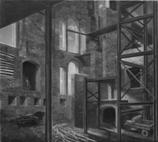 By the end of World War II, it was clear to President and Freemason Harry Truman that the White House was in need of extensive repair. The floor creaked and sagged, plaster was cracked and numerous coats of white paint all but obliterated the delicate carving adorning the exterior. A special committee determined that conditions were far worse than anticipated. The interior of the house was removed completely and the exterior walls were underpinned with stronger and deeper foundations. An independent steel frame was built within the historic shell and the interior completely reconstructed. While surveying the construction site President Truman noted unusual carvings on stones in the original walls. These were By the end of World War II, it was clear to President and Freemason Harry Truman that the White House was in need of extensive repair. The floor creaked and sagged, plaster was cracked and numerous coats of white paint all but obliterated the delicate carving adorning the exterior. A special committee determined that conditions were far worse than anticipated. The interior of the house was removed completely and the exterior walls were underpinned with stronger and deeper foundations. An independent steel frame was built within the historic shell and the interior completely reconstructed. While surveying the construction site President Truman noted unusual carvings on stones in the original walls. These were
actually chiselled signatures left by the 18th century stonemasons that identified their work. He arranged for many of these stones to be sent to Grand Lodges across the United States and issued the following statement: -
I place in your hands a stone taken from The White House…These evidences of the number of members of the Craft who built the President’s official residence so intimately aligns Freemasonry with the formation and the founding of our Government that I believe your Grand Lodge will cherish this link between the Fraternity and the Government of the Nation, of which the White House is a symbol.
Truman, 1952
The Triumph of Justice
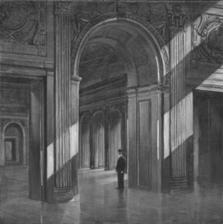
Freemason, Chief Justice and President of the United States, William H. Taft was instrumental in persuading Congress to construct a permanent home for the Supreme Court of the United States. Completed in 1935, it was designed by noted architect and Freemason Cass Gilbert in a monumental, classical Corinthian architectural style. The temple façade of a double row of sixteen columns support an architrave into which is carved Equal Justice Under the Law.
Above the architrave is a mammoth sculptural group representing Liberty Enthroned. The triumphal arch and other classical details of the Main Reading Room Law Library are constructed of hand carved oak.
Conclusion …
Where does the title of this presentation stem from you may well ask?
The Initiated Eye exhibition opened at the Octagon Museum on the 18th May 2005 and Dan Brown’s “The Lost Symbol” was released on the 15th September 2009. There are relevant parallels between both the art of Peter Waddell (born in Hastings, New Zealand) and the book of Dan Brown.
What do we have here?
Over two centuries later what occurred in history has been presented in a modern way by two self confessed non-Masons. By their joint efforts they have marketed Freemasonry, its teachings and principles to the world in a manner that we have never achieved in our history. The marketing strategy, the media frenzy and the enlightenment can only be commended and recognised by all Freemasons. In this art exhibition we have the building blocks to strengthen the public interest of our fraternity. It has been an intriguing journey for me to research and maybe a travelling exhibition of these twenty-one artworks through our combined efforts could be a starting point.
I leave the final words to Peter Waddell: -
I was at a Thanksgiving dinner and was explaining this project to the people there. No one at the table knew anything about Freemasonry, yet their eyes opened as I started telling them about the project. It seems to me that anything which helps people understand Freemasonry will help them understand the culture that contributed to the creation of this nation. Freemasonry needs to take credit for what it contributed to American philosophical thought and social values. As a historian as well as an artist, I realize there is a need to know Freemasonry and, as a result, to understand how the ideas of the Enlightenment formed the men and the documents that created America. It is important for the public to know that many of the Founders, including George Washington, were proud Freemasons. More importantly, the more people learn about the essence of Freemasonry, the more they are able to appreciate the ideals and sense of purpose that the Founding Founders had when establishing this country.
References:
Silvio A. Bedini: The Survey of the Federal Territory: Andrew Ellicott and Benjamin Banneker, Pp 76-95. Washington History, Vol. 3 Issue 1, Spring/Summer 1991, 3 (1)
Glenn V. Sherwood: A Labor of Love - The Life and Art of Vinnie Ream. SunShine Press Publications 1997
Karen Kidd: Haunted Chambers – The lives of Early Women Freemasons. Pp 156-170. Cornerstone 2009.
http://www.nationalheritagemuseum.org/Default.aspx?tabid=586
http://schooldesign.org/octagon/exhibitions/initiatedeye/index.htm
Appendix A
http://www.nbr.co.nz/article/new-zealand-artist-toast-washington-121276
New Zealand artist the toast of Washington
John Daly-Peoples | Friday April 9, 2010 - 01:15pm
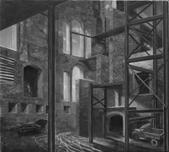
Peter Waddell, Within These Walls
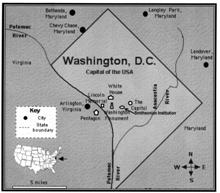 The Washington DC-based New Zealand artist Peter Waddell has just won the "Excellence in an Artistic Discipline" Award at the 25th Washington DC Mayor's Arts Awards. The prestigious awards are funded by the District of Columbia Commission on the Arts and Humanities and recognise artistic excellence and service. The Washington DC-based New Zealand artist Peter Waddell has just won the "Excellence in an Artistic Discipline" Award at the 25th Washington DC Mayor's Arts Awards. The prestigious awards are funded by the District of Columbia Commission on the Arts and Humanities and recognise artistic excellence and service.
Waddell has been based in Washington since 1995. He is currently artist-in-residence at Georgetown's Tudor Place Historic House and Garden and has executed paintings for many collections associated with the city including Mount Vernon, the Octagon in Washington DC as well as Belair Mansion in Bowie, Maryland.
Several of his works are currently included in the exhibition “The Initiated Eye: Secrets, Symbols, Freemasonry, and the Architecture of Washington, DC" on view as part of the National Heritage Museum’s exhibition. The exhibition which is on until January next year features 21 oil paintings by Waddell based on the architecture of Washington, DC, and the role that the founding fathers and prominent citizens – many of whom were Freemasons – played in establishing the layout and design of the city. The exhibition is supplemented with approximately forty objects from the National Heritage Museum’s collection.
The White House Historical Association has also commissioned the artist to produce 20 paintings showing interiors and exteriors of the White House in the eighteenth and nineteenth centuries. These paintings will form an exhibition at the White House Visitor's Centre as well as touring presidential libraries when completed.
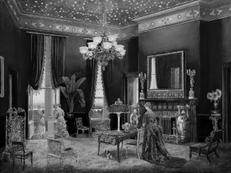
Among the paintings are three, which show the decoration of the public rooms at the White House by Louis Comfort Tiffany for President Arthur in 1882.
A two-minute film has been made to recognise the artist's achievement.
It can be found on You Tube
at www.youtube.com
Washington History Vol. 3 Issue 1 Spring/Summer 1991, 3 (1)
Benjamin Banneker (1731-1806) was a freeborn descendant of slaves who became a famous 18th-century astronomer, mathematician and surveyor. He is considered by many to be the first African-American scientist. Banneker was raised on a tobacco farm in rural Maryland, where he attended school but was largely self-taught in the sciences. Although Banneker worked most of his life as a farmer, his analytical and problem-solving skills became legendary. His achievements were indeed impressive: at age 24 he studied clockworks and constructed his own clock from wood; he taught himself astronomy and published a popular almanac, Benjamin Banneker's Almanac, from 1792 to 1797; he was appointed to assist in surveying the Federal Territory, the plot of land that was to become Washington, D.C.; he worked on calculating the precise measurement of the meter; and he corresponded with Thomas Jefferson on the issue of slavery and the intellectual equality of blacks. Banneker never married and much of his personal life is now a mystery, as his papers and belongings were destroyed in a fire that occurred on the day of his funeral.
A rostral column is a monumentally scaled column, originating in ancient Greece and Rome where they were erected to commemorate a naval military victory. Traditionally rostra, the prows or rams of captured ships, were mounted on the columns. Rostral columns of the modern world include the Columbus Memorial at Columbus Circle in New York City, and the paired Saint Petersburg Rostral Columns.
Georgetown is a neighbourhood located in the Northwest quadrant of Washington, D.C. along the Potomac River waterfront. Founded in 1751, the city of Georgetown substantially predated the establishment of the city of Washington and the District of Columbia.
.
Vinnie Ream, sculptor of the statue of Abraham Lincoln in the U.S. Capitol rotunda. Vinnie Ream was the first woman and the youngest artist to ever receive a commission from the United States Government for a statue. She was an "Omnibus" child prodigy with remarkable talent. Vinnie Ream was awarded the commission for the full-size Cararra marble statue of Lincoln by a vote of Congress in 1866 when the artist was 18 years old. Vinnie Ream also designed the first free-standing statue of a Native American (Sequoyah) to be placed in Statuary Hall at the Capitol. She built the first major monument to a U.S. Navy Officer (Admiral David Farragut) to be built in Washington, D.C. Vinnie Ream was also one of the first women to be employed by the Federal Government as a clerk in the Dead Letter Office of the United States Postal Service (USPS) from 1862-1866 during the Civil War. A First Day Cover stamp was issued in honor of Vinnie Ream and her work on the statue of Sequoyah, the Native American inventor of the Cherokee alphabet. A noted writer and singer, she helped wounded soldiers write letters and gave concerts in the Civil War hospitals. Vinnie Ream's family were Pennsylvania Dutch (Deutsch) who emigrated to the William Penn Colony in 1717 from the Palatinate region of Germany. Her grandfather fought in the American Revolutionary War. Vinnie Ream was a member of Daughters of the American Revolution (DAR). The Ream family (Rheim, Riehm) were protestants who were also thought to be French refugees. Vinnie Ream was born in Madison Wisconsin in 1847. Her father was a land surveyor and early Wisconsin Territory official. Her mother was a McDonald of Scottish ancestry. Vinnie Ream attended Christian College in Columbia, Missouri. Vinnie Ream married Richard L. Hoxie of the U.S. Army Corps of Engineers in 1878. They had one son. The Hoxies had a summer home in Iowa City, Iowa. The town of Vinita, Oklahoma was named in honour of Vinnie Ream.
Shooters Hill is a mountain summit in Alexandria (city) County in the state of Virginia (VA). Shooters Hill climbs to 144 feet (43.89 meters) above sea level.
The lighthouse of Alexandria was constructed about 280 B.C. It is known that the Hellenistic Egyptians were the builders of this. It was one of the tallest structures on Earth for many centuries. It was from 115 to 135 meters tall. It was destroyed between the years of 1303 to 1480 A.D. The cause of this was by an earthquake. It was originally made to serve as Alexandria’s port landmark, but later as its lighthouse. It is known to be the third tallest building after the two Great Pyramids. It may have been the tallest building up to the 14th century. There are claims that the light from the lighthouse could have been seen from up to 35 miles away. It was constructed from large blocks of stone, and was made up of three stages. There was a lower section with a center core, a middle octagonal section, and a circular section at the top.
http://www.ugle.org.uk/what-is-masonry/
|

